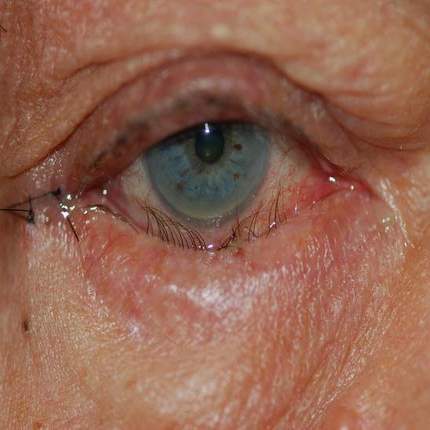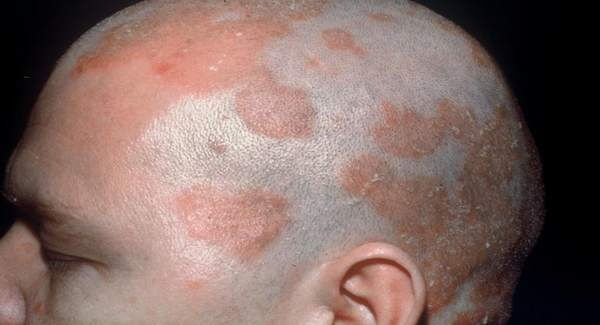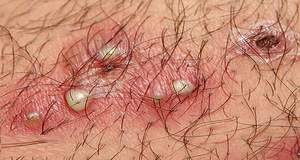What is Blepharitis?
Blepharitis (blef-uh-RI-tis) is inflammation that affects the eyelids. Blepharitis usually involves the part of the eyelid where the eyelashes grow.
Blepharitis commonly occurs when tiny oil glands located near the base of the eyelashes malfunction. This leads to inflamed, irritated and itchy eyelids. Several diseases and conditions can cause blepharitis.
Blepharitis is often a chronic condition that is difficult to treat. Blepharitis can be uncomfortable and may be unattractive, but it usually doesn’t cause permanent damage to your eyesight.
What Are the Symptoms of Blepharitis?
The symptoms of blepharitis include:
- Feeling like something is in your eye
- Burning of the eye
- Sensitivity to light
- Red and swollen eyes or eyelids
- Blurry vision
- Dry eyes
- Crusting of the eyelashes
Types of Blepharitis
Blepharitis can be divided into two sub-types based on whether it predominantly affects the anterior (front) eyelid structures or the posterior (back) eyelid structures. Some people have predominantly anterior or posterior blepharitis, and some people have both.
Anterior Blepharitis: This type affects the outside front edge of the eyelid, where the eyelashes grow, and is usually caused by bacteria (staphylococcal blepharitis) or dandruff of the scalp and eyebrows (seborrheic blepharitis). In rare cases, it is caused by allergies or an infestation of the eyelashes by mites or lice.
Posterior Blepharitis: This type of blepharitis affects the meibomian glands, which are located just within the eyelid margin. There are twenty to thirty meibomian gland openings on each eyelid margin. The inflammation causes thickening of the oil secretions so that the oil does not flow as well, causing secondary dry eye and chronic inflammation, redness, thickening, and notching of the eyelid margin. This condition may also be referred to as rosacea-associated blepharitis, because it is often seen in people with rosacea.
Causes of Blepharitis
The exact cause of blepharitis isn’t clear. Factors associated with the development of blepharitis include:
- Seborrheic dermatitis : dandruff of the scalp and eyebrows
- A bacterial infection
- Malfunctioning oil glands in your eyelid
- Rosacea : a skin condition characterized by facial redness
- Allergies, including allergic reactions to eye medications, contact lens solutions or eye makeup
- Eyelash mites or lice
- Certain medication : the severe acne medication isotretinoin (Amnesteem, Claravis, Sotret) can lead to an increase in bacteria on the eyelids and can affect tear production
Blepharitis may be caused by a combination of factors.
How Is Blepharitis Treated?
Blepharitis cannot be cured. However, it can be treated and controlled through proper eyelid hygiene. Left untreated, blepharitis can cause more serious conditions such as scarring or injury to the eye’s tissue. If you have blepharitis, take the steps listed below to help treat and cleanse your eye:
- Take a clean washcloth and wet it in very warm water. Wring the washcloth and place it over the closed eyelids for five minutes. Re-wet as necessary to maintain desired temperature. This will help to soften crusts and loosen oily debris.
- Place the warm, wet washcloth over the index finger and apply a diluted solution of 50% baby shampoo or mild soap.
- Cleanse one eye at a time, closing the eye you are cleansing, and rubbing the washcloth or your finger over the eyelashes and lid margins several times using horizontal strokes.
- Rinse thoroughly with a clean, warm, wet washcloth. Pat dry.
If the blepharitis is related to a problem with the oil glands, treatment may involve applying testosterone eye cream to the eyelids. Your doctor may also suggest a procedure known as LipiFlow, a 12-minute procedure that gently heats the clogged glands and applies mild pressure to “milk out” the unhealthy gland oils.
Prognosis of Blepharitis
In most cases, symptoms improve with treatment. For most people the condition is chronic, and symptoms may come and go. Symptoms typically recur once treatment stops. Although symptoms have the potential to be severe, blepharitis is rarely considered a serious condition.
Preventing Blepharitis
It is extremely important that you see your eye doctor at least once a year. Even if you do not have any symptoms, an eye exam is a great opportunity for you and your doctor to find out if anything is wrong, or if you have a condition such as blepharitis. Additional preventive measures you can take include:
- Keeping the area around your eyes clean with daily warm compresses and gentle lid hygiene
- Keeping your scalp clean and free of dandruff
- Treating skin disorders such as rosacea
- Avoiding dusty or smoky environments whenever possible
- Avoiding touching or rubbing your eyes, even after washing your hands
Complications of Blepharitis
If you have blepharitis, you may also experience:
- Eyelash problems. Blepharitis can cause your eyelashes to fall out or grow abnormally (misdirected eyelashes).
- Eyelid skin problems. Scarring may occur on your eyelids in response to long-term blepharitis.
- Excess tearing or dry eyes. Abnormal oily secretions and other debris shed from the eyelid, such as flaking associated with dandruff, can accumulate in your tear film the water, oil and mucus solution that forms tears. Abnormal tear film interferes with the healthy lubrication of your eyelids. This can irritate your eyes and cause dry eyes or excessive tearing.
- Difficulty wearing contact lenses. Because blepharitis can affect the amount of lubrication in your eyes, wearing contact lenses may be uncomfortable.
- Sty. A sty is an infection that develops near the base of the eyelashes. The result is a painful lump on the edge (usually on the outside part) of your eyelid. A sty is usually most visible on the surface of the eyelid.
- Chalazion. A chalazion occurs when there’s a blockage in one of the small oil glands at the margin of the eyelid, just behind the eyelashes. The gland can become infected with bacteria, which causes a red, swollen eyelid. Unlike a sty, a chalazion tends to be most prominent on the inside of the eyelid.
- Chronic pink eye. Blepharitis can lead to recurrent bouts of pink eye (conjunctivitis).
- Injury to the cornea. Constant irritation from inflamed eyelids or misdirected eyelashes may cause a sore (ulcer) to develop on your cornea. Insufficient tearing could predispose you to a corneal infection.



















